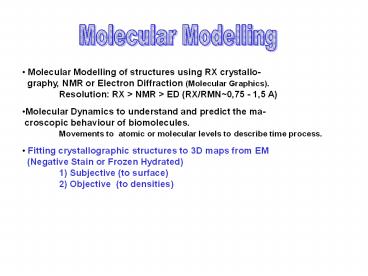Sin ttulo de diapositiva - PowerPoint PPT Presentation
1 / 20
Title:
Sin ttulo de diapositiva
Description:
graphy, NMR or Electron Diffraction (Molecular Graphics) ... Eyeglasses, Darkroom. Analog Processing. Refers to the alteration of images through electrical ... – PowerPoint PPT presentation
Number of Views:55
Avg rating:3.0/5.0
Title: Sin ttulo de diapositiva
1
Molecular Modelling
- Molecular Modelling of structures using RX
crystallo- graphy, NMR or Electron Diffraction
(Molecular Graphics). Resolution RX gt NMR gt
ED (RX/RMN0,75 - 1,5 A) - Molecular Dynamics to understand and predict the
ma- croscopic behaviour of biomolecules.
Movements to atomic or molecular levels to
describe time process. - Fitting crystallographic structures to 3D maps
from EM (Negative Stain or Frozen Hydrated)
1) Subjective (to surface) 2) Objective (to
densities)
2
Image Processing
Visually enhance (subjective) or statistically
(objective) evaluate some aspect of an image not
apparent in its original form.
- Optical Processing. Uses optics to carry out
a process. Eyeglasses, Darkroom - Analog Processing. Refers to the alteration of
images through electrical means. Brightness
and contrast controls on a TV - Digital Image Processing Same as above but on
a computer
One picture is worth more than ten thousand words
3
History
A digital picture produced in 1920 from a coded
tape by telegraph printer with special type
faces. Transmitted via submarine cable from
London to New York for newspapers
Cable picture transmitted by 15-tone equipment
from London to New York in 1929
4
The Digital Image Processing System
Mass Storage
Image
Digital Computer
Operator Console
Digitizer
Display
5
The Digital Image Processing System
Image
Digitizer
- Microdensitometers Negatives or photographs are
scanned by light beam recording the gray level
either by transmission or by reflection. - Flat bed (scanners)
- Wrapped around a drum
- Digital sensors Remote sensors used by satellite
surveillance - Video scanners Use a video camera to acquire the
image to be converted to a digital image.
6
Image Adquisition
A/D ConverterQuantization
- The digital image processor converts a continuous
tone image to discrete points of information
(sampling quantization or digitizing). - A sample point is referred to as a picture
element or pixel. - An image is digitized into a grid of pixels (n
columns m rows) - Each pixel is a number (digital), that represents
the brightness of the original picture.
7
Origin
Digital Image
- Two dimensional light intensity function f(x,y),
where x and y denote spatial coordinates and the
value of f at any point (x,y) is proportional to
the brightness (or gray level) of the image at
that point.
Image elements, picture elements, pixels or pels
8
Spatial Resolution
- Describe how many pixels an image is divided
into. - The finer the resolution, the closer we approach
to the appearance of the original image.
Units DPI, PPI
Spatial Frequency
- The rate at which brightness of an image changes
from dark to light. Details range from minutely
detailed in space cloth or moon surface to smooth
varying shades in the overall scene.
9
Brightness Resolution
- This is concerned with how accurately the
digital brightness of each pixel resembles the
original brightness. - The number of gray levels (G) can be represented
in each pixel. - G 2m
- G2 means m1 G8 means m3 G256 means m8
10
Brightness Resolution
- How many gray levels can see a human been?
- The human vision is a result of a combination of
brightness adaptation and contrast sensitivity of
the eye. - Experimentally the human eye can detect only one
or two dozen in intensity levesl, but to obtain a
display that will appear reasonably smooth to the
human eye a range over 100 intensity levels is
generally required.
11
Image Histogram
- A histogram of gray levels provides a global
description of the appearance of an image. - N(b) is a function of the number of pixels (N)
with the same gray level (b).
12
Histogram Transformations
13
Negatively Stained Tarantula Thick Filament
43.5 nm
14
Discontinuous Helices
Helical repeat 43.5nm
43.5nm/14.5nm3
14.5nm
14.5nm Sub-units separation
1/p Subunits separation
- The myosin heads on the surface of myosin
filament are arranged with helical geometry. - In Tarantula muscle they form 4 helices with a
helical repeat of 43.5nm, and a separation
between sub-units of 14.5nm
Subunits separation 1/43.5nm-10.023nm-1
1/14.5nm-1
1/P Helical repeat
15
Fourier Transform
F(u) ? ? (x) exp-j2??x dx -?
One-dimensional
Two-dimensional
16
Discontinuous Helices
Helical repeat 43.5 nm
43.5nm/14.5nm3
14.5 nm
14.5 nm Subunits separation
1/p Subunits separation
Subunits separation 1/43.5nm-10.023nm-1
1/14.5nm-1
1/P Helical repeat
17
FFT
18
Lowpass Filter
- Ideal lowpass filterAll the frequencies inside
a circle of radius D0 are passed with no
attenuation, while all frequencies outside this
circle are completely attenuated. - Trapezoidal lowpass filter
- Butterworth lowpass filter
- Exponential lowpass filter
19
Lowpass Filter
90 95 98 99 99.5 99.9
20
Lowpass Filter
Ideal
90 95 98 99 99.5 99.9































